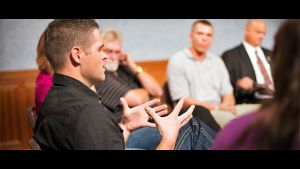Difference between revisions of "Mormon 12-Step Addiction Recovery Program"
m |
m |
||
| Line 1: | Line 1: | ||
[[Image:addiction-recovery-program.jpg|alt=Addiction Recovery Program|right|frame|Mormon 12-Step Addiction Recovery Program]] | [[Image:addiction-recovery-program.jpg|alt=Addiction Recovery Program|right|frame|Mormon 12-Step Addiction Recovery Program]] | ||
| − | In a new video published by Mormon Channel.org on 1 September 2015, Dr. Kevin McCauley uses visual images to help people who are going through recovery to feel better understood, and to help their family and friends envision that recovery is possible regardless of the addiction a person is struggling with. In the video, Dr. McCauley points out: | + | <videoflash>XwYASU-YVcw&rel=0</videoflash> |
| + | |||
| + | In a new video published by Mormon Channel.org on 1 September 2015 (shown above), Dr. Kevin McCauley uses visual images to help people who are going through recovery to feel better understood, and to help their family and friends envision that recovery is possible regardless of the addiction a person is struggling with. In the video, Dr. McCauley points out: | ||
:Addiction is never an escape from responsibility for our choices and our actions, but it does affect our brains like a disease that is difficult to control. Because addiction rewires the brain, the substances and behaviors we are addicted to may seem impossible to quit. However, there is hope; the brain can change. | :Addiction is never an escape from responsibility for our choices and our actions, but it does affect our brains like a disease that is difficult to control. Because addiction rewires the brain, the substances and behaviors we are addicted to may seem impossible to quit. However, there is hope; the brain can change. | ||
| − | |||
| − | |||
| − | |||
| − | |||
=Hope of Recovery is found through the Healing Powers of the Great Physician= | =Hope of Recovery is found through the Healing Powers of the Great Physician= | ||
Revision as of 16:19, 8 September 2015
In a new video published by Mormon Channel.org on 1 September 2015 (shown above), Dr. Kevin McCauley uses visual images to help people who are going through recovery to feel better understood, and to help their family and friends envision that recovery is possible regardless of the addiction a person is struggling with. In the video, Dr. McCauley points out:- Addiction is never an escape from responsibility for our choices and our actions, but it does affect our brains like a disease that is difficult to control. Because addiction rewires the brain, the substances and behaviors we are addicted to may seem impossible to quit. However, there is hope; the brain can change.
Hope of Recovery is found through the Healing Powers of the Great Physician
A person who is struggling with an addiction may at times feel that there is no hope for recovery. He or she may at times ask the same question that the prophet Jeremiah asked, “Is there no balm in Gilead; is there no physician there?” Jeremiah 8:22. The answer is that Jesus Christ, the Great Physician, is that balm in Gilead. Elder Patrick Kearon of the Quorum of the Seventy has taught, “We find healing and relief only when we bring ourselves to the feet of the great physician: our Savior, Jesus Christ.”
The Twelve-Step Addiction Recovery Program
The Church of Jesus Christ of Latter-day Saints has developed a 12-step addiction recovery program that is available to members and non-members alike in an effort to help “strengthen the weak hands, and confirm the feeble knees” Isaiah 35:3 of those who are struggling with addictions. Family members of the person seeking recovery are also encouraged to attend the program.
Using the twelve steps of Alcoholics Anonymous as a foundation, a program has been developed that is gospel principle-based and incorporates the framework of the doctrines, principles, and beliefs of The Church of Jesus Christ of Latter-day Saints. Each of the twelve steps are presented as a key principle, and each attendee learns how to apply the principles to experience change in their life.
The Church’s web page where information about the Addiction Recovery Program can be found states:
- These steps from the Addiction Recovery Program guide are intended to be a workbook and reference for those attending addiction recovery support groups sponsored by LDS Family Services. However, the doctrines and principles that are taught could also be of great benefit to those who live where participation in a support group is not feasible. It can be used by people seeking to change their lives and especially by those willing to work one-on-one with a bishop or a professional counselor.
The process of developing the content for the program was two-fold. Men and women who have suffered the life-changing effects of various addictions were invited by LDS Family Services to share their stories, followed by their testimonies of how applying the principles taught helped put them on a road to recovery. Church leaders and counseling professionals were also involved in writing and developing the content. According to the web page, “The combined wisdom and experience of these many authors stands as yet another witness of the reality of the Atonement of Jesus Christ and the possibility of recovery from addiction.”
Commencing on 1 September 2015, Mormon Channel.org launched a 12-part video series with each step of the recovery program being discussed in each perspective video. You can watch the trailer for the series below:
12 Steps of the Program
The 12 steps of the program are as as follows:
- Honesty
- Hope
- Trust in God
- Truth
- Confession
- Change of Heart
- Humility
- Seeking Forgiveness
- Restitution and Reconciliation
- Daily Accountability
- Personal Revelation
- Service
